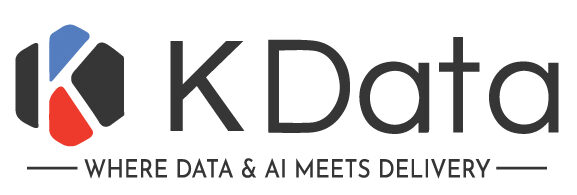Introduction
According to Statista report (2024), 73% of firms migrate their on-premise legacy systems to cloud solutions. The global market size of cloud migration is estimated to be 10514.5 million USD in 2024. This is due to the growing need for remote working models, flexible IT infrastructure, and business agility, which leads enterprises to adopt the cloud environment. Cloud computing is gaining popularity due to its flexibility, cost efficiency, performance and other benefits that have attracted enterprises to transform or update their legacy business models. Though migration can deliver fruitful benefits, it also poses a set of challenges. This includes security & compliance issues, legacy systems compatibility, technical complexities, stakeholder readiness, migration costs, skill or resource shortage and other operational considerations. A thorough knowledge of these challenges and taking measures to overcome them is crucial for firms looking to reap the cloud benefits while preventing disruptions and ensuring a smooth migration process. However, organizations failed to plan and prepare for the migration challenges, resulting in unexpected consequences and unmet migration goals. This article delves into the common cloud migration challenges, providing insights on how to address them.
Common Cloud Migration Challenges and Solutions
Cloud migration challenges are difficulties and constraints that organizations face while transferring data, applications, business processes, and infrastructure from an on-premise framework to the cloud platform. Cloud migration offers numerous benefits to optimize business operations through improved performance, increased flexibility, scalability, business agility and cost-efficiency. However, it is a considerable procedure that requires meticulous planning and implementation of a series of strategic processes. Better knowledge about challenges and plans can help an enterprise effectively handle them to reap the benefits of transition and achieve business goals. Below are key challenges that organizations encounter and solutions to address them proactively.
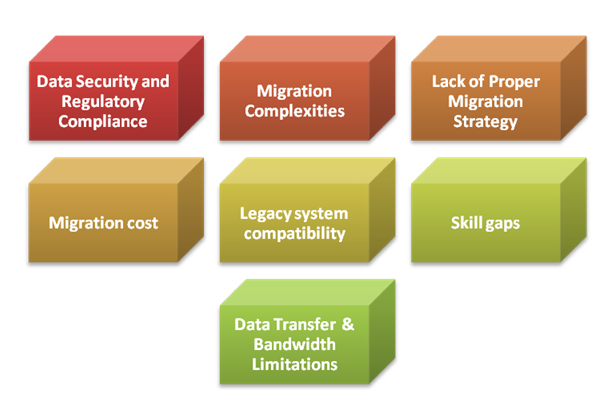
1. Data Security and Regulatory Compliance
Data Security and compliance risks are the key concerns of cloud migrations, as they expose vulnerabilities during data transfers. Cloud-hosted data and applications must adhere to stringent security protocols like on-premise systems, so enterprises face added compliance challenges. They must consider stringent regulatory compliance with CCPA, HIPAA and GDPR to manage and secure data. There is a lack of responsibility and understanding between an organization and the cloud provider. Also, there is no strategic plan for data encryption, security audits, or multi-factor authentication. Eliminating these challenges is crucial to prevent data breaches and the firm’s reputational damage and avoid legal penalties. Key Challenges include,
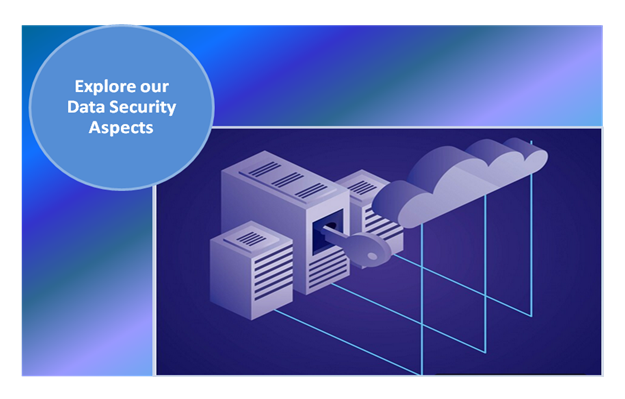
Solutions
- Partner with certified cloud providers who have proven track records in cloud platforms.
- Ensure they offer robust security features and evaluate compliance tools regulated by CCPA, HIPAA, and GDPR. Conduct regular audits to ensure data security.
- Employ secure network connectivity for sensitive data transfers instead of choosing public networks.
- Categorize data based on its sensitivity level and implement the proper security controls.
- Improve access control by implementing MFA (Multi-Factor Authentication).
- Understand the Shared Responsibility Model: This model dictates that while cloud providers manage the infrastructure, organizations are responsible for safeguarding their data and applications. This understanding is crucial for effective cloud migration planning and execution.
- Monitor for unauthorized data access or breaches regularly
- Craft a Data Loss Prevention (DLP) and Data Governance plan that covers encryption, audit mechanisms and multi-factor authentication.
2. Migration Complexities
Organizations underestimate the challenges of cloud migration quickly and think of just porting the legacy system to the cloud, thus experiencing complexities in the project. The data type, size, and dependencies must be accounted for when transitioning to a new cloud infrastructure, making the process a challenging riddle. Compatibility issues with data while restructuring or reformatting problems with hardware, software and network connectivity, and lack of coordination between personnel all contribute to serious migration challenges. This can lead to project failure, productivity setbacks, cost overruns, and serious downtime.
Solutions
To solve this,
- Conduct a thorough analysis of the current infrastructure to identify dependencies or compatibility issues that could disrupt migration.
- Draw a detailed roadmap, ensuring the legacy system seamlessly integrates with the new, sleek cloud infrastructure, which aligns with specific business requirements.
- Implement a phased approach involving a stage-by-stage migration process instead of migrating the entire workload simultaneously.
- Have a contingency plan to avoid data loss and other complexities during migration.
3. Lack of Proper Migration Strategy
Proper planning is the cornerstone of a successful cloud migration. Without it, the process can be fraught with prolonged timelines, cost overruns, and potential disruptions to business functions. A well-planned cloud migration strategy covering workload prioritization, a detailed budget, a realistic timeline, and resources (human & technical) is essential for a successful transition. Rushing into the adoption of cloud infrastructure without a clear roadmap can lead to costly mistakes.
- Choosing an improper cloud provider for an organization’s specific needs and requirements represents poor planning.
- Failure to assess the specific business requirements could result in low performance with increased time and higher costs.
- Poor analyses and prioritization of workloads and human/technical resources can lead to difficulties.
- No plan for post-migration testing and troubleshooting to identify pitfalls and rectify them in post-migration.
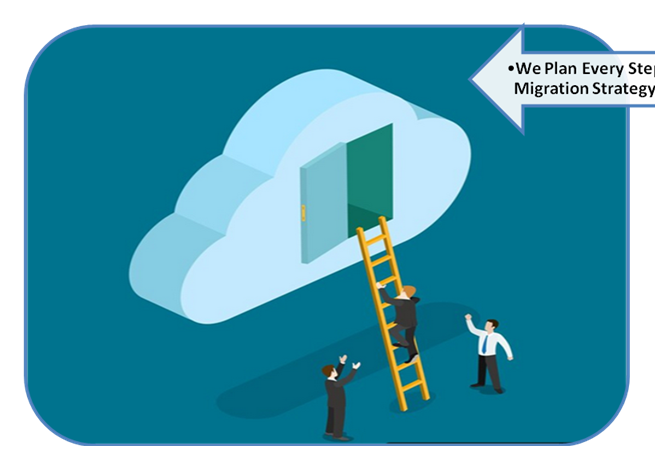
Solutions
Being unclear on these aspects can lead to an ideal cloud strategy being a failed one. Solutions to consider are,
- Brainstorm a best-fit strategy covering overall migration goals aligned with the organization’s specific requirements, including what and why to migrate and who are responsible personnel for each stage.
- Create a strategic action plan covering cost estimation, suitable cloud model, current assets with required resources, data workflows, and estimated downtime to achieve seamless migration.
- Craft a roadmap that outlines the transition process by considering security concerns, technology adoption, dependencies, latency, and assessing workloads.
- Map milestones by defining workflows and prioritizing workloads & resources to ensure a smooth transition process.
- Conduct post-migration testing and troubleshooting, which may include optimizing security and performance, ensuring data integrity, and identifying and rectifying any post-migration issues. Regular optimization is key to maintaining the efficiency and security of the cloud environment.
4. Migration Cost
Organizations want to jump into cloud migration, hoping for immediate cost benefits. However, the reality may entail considerable upfront costs, potential operational costs, and post-migration costs. Firms often underestimate the total costs incurred for the transition, which includes
- New network connectivity must be able to manage increased bandwidth demands and
- Assess post-migration costs to operate workloads in the new cloud infrastructure.
In addition, they can encounter unexpected challenges like data compatibility concerns, sudden technical problems, or the need for additional human or technical resource requirements midway. Therefore, gauging the total migration costs is challenging.
Solutions
Though cloud migration is highly efficient in the long run, the cost incurred for this is high. To avoid cost overruns,
- Conduct a cost analysis to understand the cost of running the current systems and applications in the new cloud.
- Perform a comprehensive assessment of the existing applications to identify potential bottlenecks and areas needing considerable improvement for successful migration.
- Set a detailed budget that includes upfront costs, post-migration costs, and the costs associated with unexpected expenses like data compatibility and technical issues during migration.
- Choose an experienced cloud provider who can suggest various pricing models and cost-monitoring tools to minimize unforeseen expenses.
- Utilize resources in an optimized way to avoid over-provisioning.
5. Legacy System Compatibility
Transition to the cloud environment is fruitful, but the path towards employing them is not always smooth. A key challenge organizations face is the current system compatibility with the new cloud environment involves several compatibility issues, such as
- Applications and systems built for on-premise settings may not perform well when interacting with cloud platforms. This incompatibility is caused by outdated technologies, software dependencies, and customized applications that do not fit precisely into the new environment.
- Legacy systems have complex interdependencies with other databases or software applications. In the cloud environment, they may lack encryption mechanisms and robust security features.
- Lack of testing and validation during migration could fail to overcome compatibility issues.
Solutions
To overcome these challenges,
- Conduct an in-depth analysis of legacy application data, architectures and dependencies during the planning phase to discover the earliest possible compatibility errors and integration points.
- Consider re-engineering or re-factoring the legacy system to optimize its adaptability with the cloud platform.
- Conduct rigorous testing and validation of applications in the cloud during the transition to overcome potential issues before they arise.
- Constantly monitor the post-migration performance on the new cloud or hybrid systems to avoid disruptions and uphold a cohesive system, especially for managing and securing sensitive data.
6. Skill gap
Migrating to cloud computing infrastructure involves several complex tasks that require deploying new infrastructure & technologies, migration best practices and skilled cloud professionals. These expertise must,
- Follow migration best practices to manage applications & secure data in the cloud,
- Identify bottlenecks and resolve them promptly
- Discover Key Performance Indicators (KPIs) and make informed decisions
- Optimize resource utilization
- Identify possible roadblocks and overcome dependencies.
Hence, organizations lacking internal capacity and cloud expertise may face serious impediments in a seamless migration.
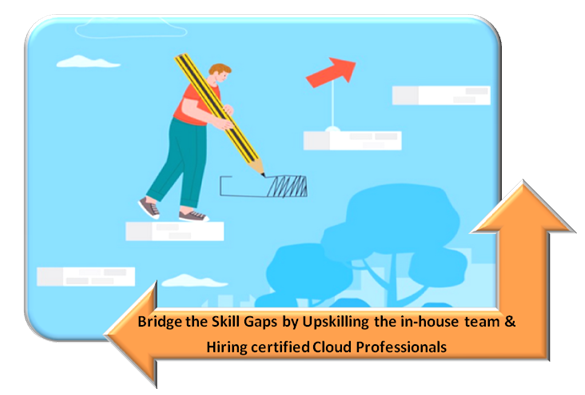
Solutions
To overcome this, firms can
- Figure out an appropriate strategy for human resources to overcome skills shortage.
- Upskill the in-house team by providing training and skills development to build cloud skills. Please encourage them to continue learning to stay up-to-date on the latest technologies.
- Partner with a dedicated cloud company with a specialized skill set to efficiently migrate and manage the infrastructure.
Hire certified talents of security specialists, cloud architects and engineers who are familiar with Azure, AWS, GCP and other cloud platforms.
7. Data Transfer & Bandwidth Limitations
Another daunting cloud migration challenge is the vast data transfer to the new cloud platform. When data transmission occurs with critical applications or voluminous data, it consumes much time, leading to productivity delays and increased downtime. The data transfer process is highly reliant on the availability of the network bandwidth. If an organization has limited network capacity, it could slow down the transition process, which could cause poor user experience. It is necessary to define the bandwidth requirements for the cloud provider clearly. Typically, cloud applications should perform exceedingly or match in-house deployments. The migrated system will face latency and unfilled business requirements if the bandwidth requirements are unclear.
Solutions
- Accounting for the network constraints before migration is essential. It helps to assess the on-premise application performance and identify potential areas for improvement.
- Firms can overcome bandwidth limitations with efficient migration strategies. These strategies entail prioritizing key data, incremental data moves, or applying data compression techniques to better use the available bandwidth.
Conclusion
When an enterprise plans to migrate to the cloud platform, it may experience one or many of these challenges. Knowing these migration barriers before the transition begins and identifying solutions to overcome them will help firms streamline their business operations.In turn, the benefits of cloud migration can outweigh the challenges. Hence, to overcome these challenges, evaluate the on-premise workloads, develop a strategic migration plan, get expert guidance, manage costs effectively, and employ industry best practices.
At KDATAAI, we assist you in every stage of the migration journey to unlock the full potential of the cloud environment. We handle projects of any size, plan every process meticulously, manage carefully, optimize resource utilization, minimize cloud costs, strengthen security, enhance data processing efficiency, and maximize ROI.
Make your cloud migration a smooth transition with KDATAAI!
